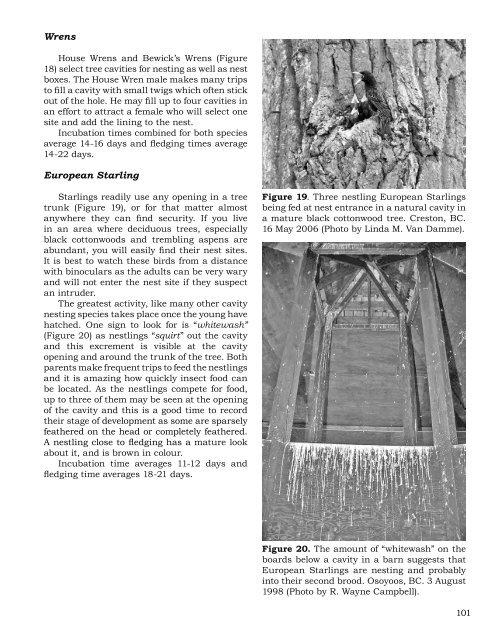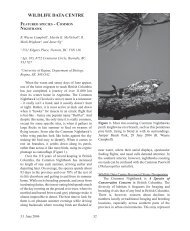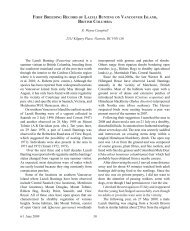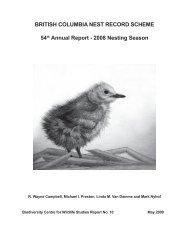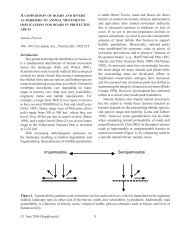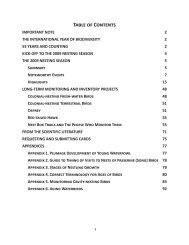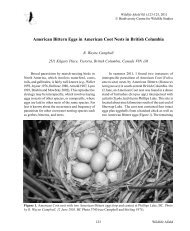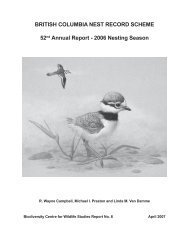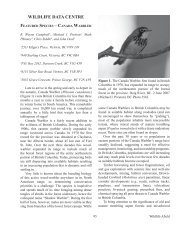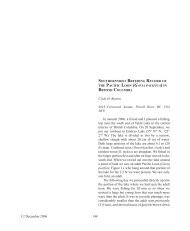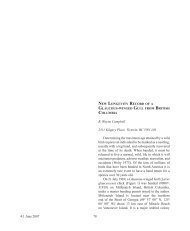2010 Nesting Season - Biodiversity Centre for Wildlife Studies
2010 Nesting Season - Biodiversity Centre for Wildlife Studies
2010 Nesting Season - Biodiversity Centre for Wildlife Studies
You also want an ePaper? Increase the reach of your titles
YUMPU automatically turns print PDFs into web optimized ePapers that Google loves.
Wrens<br />
House Wrens and Bewick’s Wrens (Figure<br />
18) select tree cavities <strong>for</strong> nesting as well as nest<br />
boxes. The House Wren male makes many trips<br />
to fill a cavity with small twigs which often stick<br />
out of the hole. He may fill up to four cavities in<br />
an ef<strong>for</strong>t to attract a female who will select one<br />
site and add the lining to the nest.<br />
Incubation times combined <strong>for</strong> both species<br />
average 14-16 days and fledging times average<br />
14-22 days.<br />
European Starling<br />
Starlings readily use any opening in a tree<br />
trunk (Figure 19), or <strong>for</strong> that matter almost<br />
anywhere they can find security. If you live<br />
in an area where deciduous trees, especially<br />
black cottonwoods and trembling aspens are<br />
abundant, you will easily find their nest sites.<br />
It is best to watch these birds from a distance<br />
with binoculars as the adults can be very wary<br />
and will not enter the nest site if they suspect<br />
an intruder.<br />
The greatest activity, like many other cavity<br />
nesting species takes place once the young have<br />
hatched. One sign to look <strong>for</strong> is “whitewash”<br />
(Figure 20) as nestlings “squirt” out the cavity<br />
and this excrement is visible at the cavity<br />
opening and around the trunk of the tree. Both<br />
parents make frequent trips to feed the nestlings<br />
and it is amazing how quickly insect food can<br />
be located. As the nestlings compete <strong>for</strong> food,<br />
up to three of them may be seen at the opening<br />
of the cavity and this is a good time to record<br />
their stage of development as some are sparsely<br />
feathered on the head or completely feathered.<br />
A nestling close to fledging has a mature look<br />
about it, and is brown in colour.<br />
Incubation time averages 11-12 days and<br />
fledging time averages 18-21 days.<br />
Figure 19. Three nestling European Starlings<br />
being fed at nest entrance in a natural cavity in<br />
a mature black cottonwood tree. Creston, BC.<br />
16 May 2006 (Photo by Linda M. Van Damme).<br />
Figure 20. The amount of “whitewash” on the<br />
boards below a cavity in a barn suggests that<br />
European Starlings are nesting and probably<br />
into their second brood. Osoyoos, BC. 3 August<br />
1998 (Photo by R. Wayne Campbell).<br />
101


